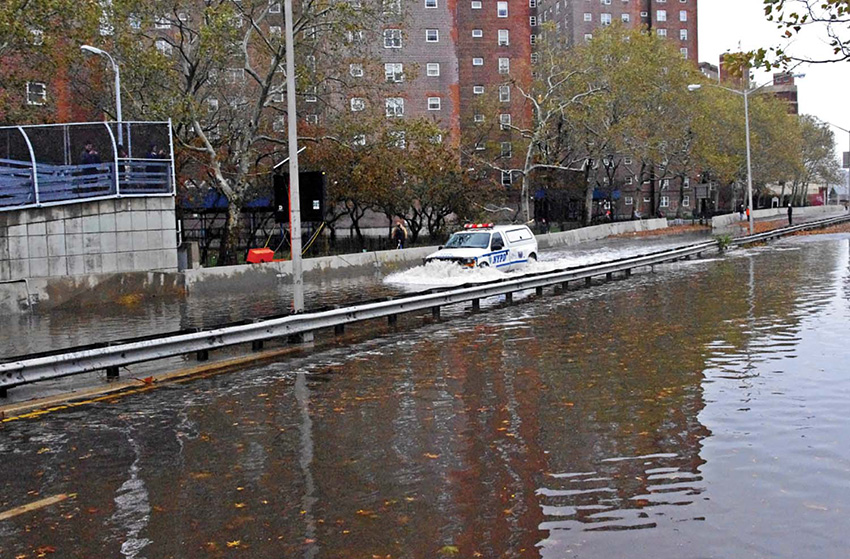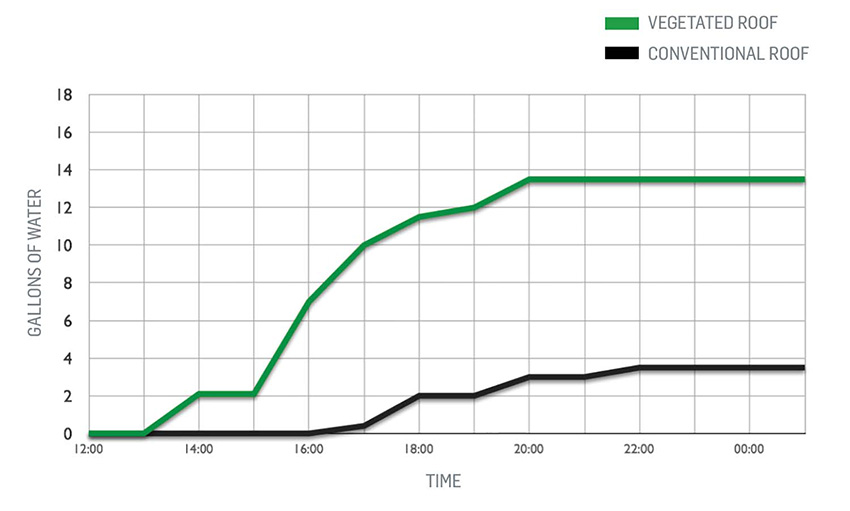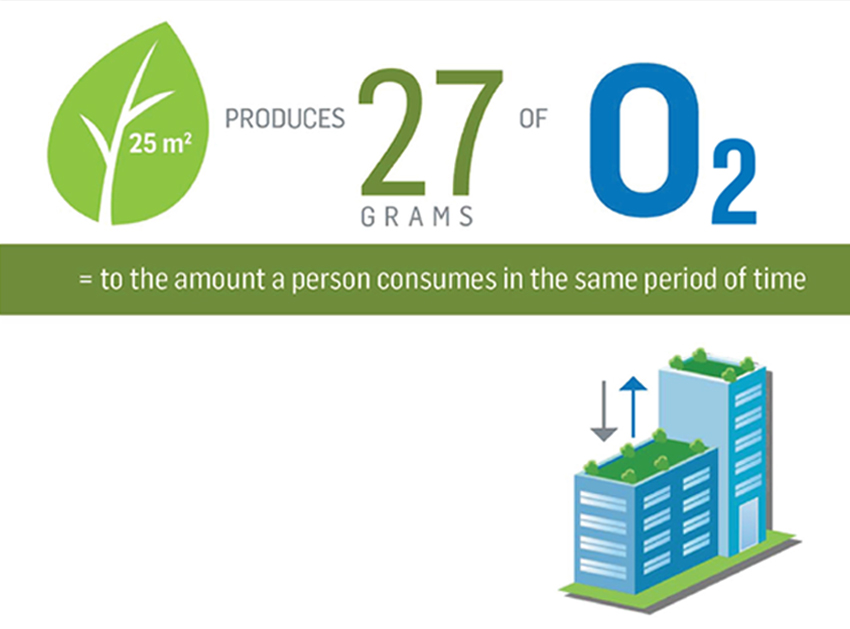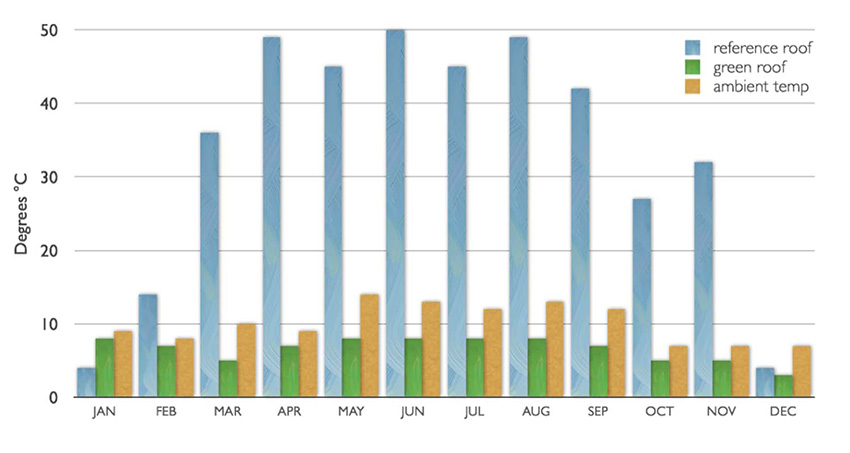Vegetated Roof Systems
Benefits of Vegetated Roofs
There are many social, environmental and economical benefits to installing vegetated roofs on your building. While all vegetated roofs have similar functions, each installation is unique and technical performance can vary by region, climate, building and green roof type and design. The benefits described below can be achieved by virtually all green roof systems and designs.
Rainwater management—a green roof acts like a sponge, taking in water as it rains and releasing it to the plants in the system, which prevents spiking in water levels in cities’ rainwater runoff systems. For example, Portland, Ore., utilizes numerous rainwater management solutions, including vegetated roofs. Washington, D.C., New York City and Philadelphia are also leading the way using vegetated roofs as a rainwater management tool.
Rainwater management is actually the most important benefit of modern-day green roofs. Urban environments contain large amounts of impervious surfaces. Most large cities have combined sewers, so your rainwater and sewage go into one pipe. With heavy rain events the single pipe becomes overburdened. This overburden causes Combined Sewer Overflow events (CSO’s). However, green roofs can assist with rainwater management and mitigate any possible issues.

Rainwater management is one of the most important benefits of vegetated roofing systems. Green roofs reduce the amount and rate of rainwater runoff.
Runoff comparison—gallons of water are collected on a roof during a six-hour storm event. Not only do vegetated roofs retain water, but they also detain. This is just as important, as it lessens the burden on the rainwater infrastructure. Vegetated roofs are designed to decrease runoff-related pollution of natural waterways.

This graph illustrates how the amount of water collected during a six-hour storm event (measured in gallons) will differ when vegetated and conventional roofing systems are in use.
Convert CO2 to O2—vegetated roofs also convert carbon dioxide (CO2) to oxygen (O2). Plants help remove particulate matter from the air while adding oxygen to the environment, improving our air quality and combatting greenhouse effects.

Vegetated roofs will convert carbon dioxide to oxygen, which helps to sustain human and animal life.
Natural water filtration—natural water filtration can be affected by the use of a vegetated roof. Heavy metals carried by the rain are bound in the roof instead of being discharged. With green systems, 95 percent of cadmium, copper and lead are filtered out of the runoff.
Protect your investment—vegetated roofing also protects your investment. This type of system guards roof membranes against harmful ultraviolet radiation, extreme temperature fluctuations, heat aging and physical damage. As a result, this type of roof structure can require less maintenance, saving the owner money in replacement costs over the long-term life of the roofing system. If the roof is well maintained, it will last longer than a standard roof, making up some of the upfront costs of installation.
Noise reduction—noise bounces off of flat, hard surfaces, but covering these surfaces with plant life can dampen that sound. Green roofs have excellent noise attenuation, especially for low frequency sounds. The substrate blocks lower frequencies, while plants can block higher frequencies. A 4-inch layer of growing medium on this type of roof system can reduce sound up to 20 dB.
Reduce heat island effect—many cities deal with urban heat island effects when sunlight and attendant heat energy are absorbed into materials with dark surfaces. Green roofs help mitigate this by cooling the air through a process called evapotranspiration. On a 90-degree day, a traditional roof can exceed 160 degrees Fahrenheit. However, under the same conditions, a green roof will typically emit a temperature of only 95F. Lower rooftop temperatures mean less smog and improved air quality.
Energy efficiency—the greater insulation and surface performance offered by green roofs can reduce the amount of energy needed to moderate the temperature of a building, as roofs are the sight of the greatest heat loss in the winter and the hottest temperatures in the summer. For example, research published by the National Research Council of Canada found that an extensive green roof reduced the daily energy demand for air conditioning in the summer by over 75 percent (Liu 2003). This energy efficiency was achieved by increasing the R-value of the roofing system through the components of the green roofing system and the effects of evapotranspiration to lower surface temperatures. Evapotranspiration is the process by which water is transferred from the land to the atmosphere by evaporation from the soil and other surfaces and by transpiration from plants. This evaporation process can create a cooling effect on surface temperatures and can offer performance results similar to a highly reflective roof surfacing.
There are resources available to assist in the estimated energy savings of a green roof—The Green Roof Energy Calculator co-developed by Green Roofs for Healthy Cites (GRHC) with the University of Toronto and Portland State University allows you to compare the annual energy performance of a building with a vegetative green roof to the same building with either a conventional roof or a highly reflective roof.
Temperature fluctuation differences—green roofs modify temperature fluctuations of the membranes, thereby reducing thermal stress and possibly extending membrane life. On one hand, a dark, heat-absorbing roof surface increases demands on mechanical systems, making it more difficult to adequately cool a building. On the other hand, a green roof reduces the temperature of the roof’s surface, and therefore, the building itself. The layers of a green roof decrease the amount of heat being absorbed by the building.
Civic benefits—besides water management, there are additional civic benefits of installing green roofs. Secondary benefits of green roofs include more opportunities for urban farming, creation of urban wildlife habitats, and formation of environments that are simply more pleasant to interact with than traditional commercial rooftops.
Green roof requirement—some cities, especially in Europe, require newly constructed commercial buildings to have green roofs to help address urban environmental problems and foster sustainable development. As previously mentioned, Germany is considered a pioneer in green roofing. At least 150 cities in Germany already require vegetated roofs with new construction projects and requirements exist throughout many other countries as well. If the pending bill in San Francisco is passed, it may not be long before we see more U.S. cities joining this list.
Incentives—while green roofs can be required by some municipalities, they are more commonly encouraged simply through financial incentives. When incentives are combined with the inherent benefits of vegetated roofs, these sustainable choices become even more appealing. For example, Portland, Ore., incentivizes the development of green roofs by offering grants and highly visible campaigns featuring rooftop events and installation of green roofs on public buildings. Cities like Washington, D.C., New York, Chicago and Philadelphia lead the country in green roof installations as a response to rainwater management initiatives and other related incentives.
Environmental stewardship—companies like Ford, Walmart, FedEx and others, install green roofs as part of their corporate sustainability initiatives or to create goodwill with stakeholders. In south Chicago, a plant that produces Method cleaning products features a large produce growing operation on the rooftop. At Columbia University, where research pertaining to the benefits of green roofs takes place, tens of thousands of square-feet of on-campus buildings boast green rooftops.

This chart illustrates how green roofs modify temperature fluctuations of roofing membranes, reducing thermal stress.









